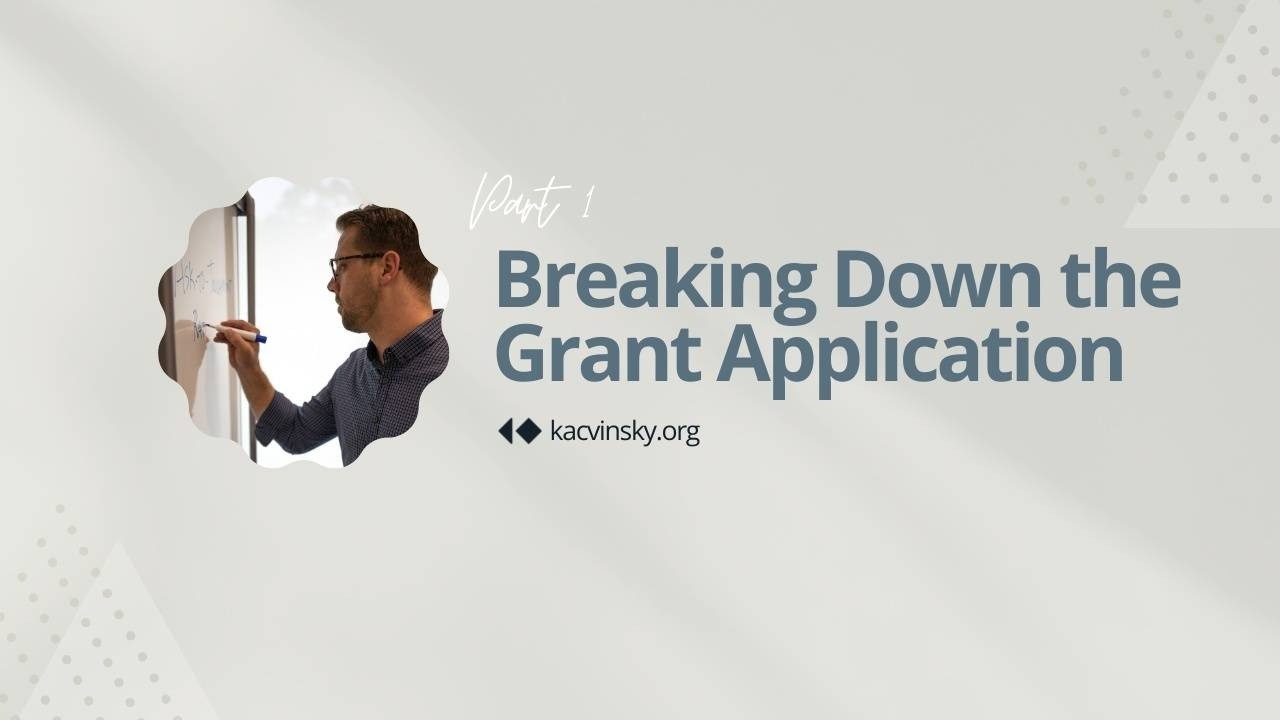Breaking Down the Grant Application - Part 1
Feb 28, 2022
This is part one of a two-part series walking you through a typical grant application. Part two can be found here.
If you want to write for grants, it will only take you two or three applications to see a pattern emerging of what the potential funders are looking to gather. Typically, a grant application will include a section asking for the nonprofit's general information, an executive summary, a statement of needs, a description of the project, and then the budget for the project. Here is an explanation of each section of a grant application, along with some tips and tricks to make your project more fundable.
General Information:
Most grant applications will ask for some general information. It will likely include your official name, contact for your organization, board members and leadership team members, your EIN, IRS letter, mission statement, and a narrative about what you do. If there is no section asking for this information, you can make your own with the information above.
This section is vital because unless someone hands this application to a reviewer with a personal explanation, the person reading your application will have no idea what you do. Keep it clear and focused and show the value you provide. Here are some Pro Tips:
- If you have been around for more than 4 or 5 years, make sure you include when you were founded to show you have some history.
- In a narrative about what you do, be sure to highlight the general concept of what your application is trying to accomplish. For example: if this is for a college-graduation program, be sure you highlight some of your primary activities and services related to college graduation and how many graduated you can track through college graduation so far.
- Describe those who benefit from your organization and the outcomes you have produced so far. This clarifies that you are effective and that the money the funder gives you will have a positive impact.
Executive Summary:
The executive summary is the first thing the potential funder will read, so please spend the most time mastering this piece. Many nonprofits have great projects but do not get funding because their executive summary is boring and uninspired. Do not use canned content for this; wait until you have a clear understanding of your project, work out the budget and everything you need, and make sure you know how your project fits into the funder's goal and giving initiatives before beginning to write.
I love to start with an attention-grabbing line or two that speaks to the problem you are addressing and invites the funder to take the credit for that work.
Only 15% of low-income, first-generation high school students will graduate from college. But it doesn't have to be that way! This [insert initiative as foundation lists it – ex: "access to education"] grant application explains how a partnership between [Foundation Name] and [Organization Name] will result in a 300% increase in the likelihood that the same population will graduate from college. We are well on our way, but we need your help on a program to strengthen our college prep summer program.
Follow the attention-grabbing intro with a summary of the other sections of the grant application. You should not do this until the application is complete not to miss something important. I like to end the executive summary with a brief description of the organization in a way that lends credibility to your organization. I also recommend that you list any other funds or funders already secured. Funders typically love to know that they are not the only ones funding a project.
The requirements will tell you how long it should be, but typically executive summaries are around one page long. They are most typical on grants that are several pages in length, and some shorter grants do not require an executive summary.
Pro Tip: I have mentioned several times that funders do not want to be the only ones giving, and they want to see the impact of their gift. Along these same lines, one way to increase your likelihood of getting funded is to explain that your project, following this grant, will be sustainable. If you can honestly say that it will be sustainable, state that in the executive summary and then break it down more in the project description or the budget section.
Statement of Needs:
The Statement of Needs explains how the proposed project addresses a real problem. I encourage organizations to use facts and figures in this section and focus on those who are the actual beneficiaries of the project.
Do not fall for the amateur move of explaining your origination's needs. This section is about the need for the project, not your nonprofit's need for funds. All nonprofits need funds for projects; that's already assumed – ahem, it's a grant application!
This is your opportunity to show a deeply personal impact by introducing a member of your community or sharing a real-life story. You can show the local impact but explain how many people you have already served, and I encourage you to show your cause's global impact. Answer this question: If your project is successful, what are the ripple effects of the result.
As we have shown in the facts and figures presented, college graduation is a leading indicator (though not the only indicator) of a person's ability to generate a higher income and thus provide for their family as a productive member of society. Therefore, an investment in helping low-income, first-generation graduates from college is ultimately ending generational poverty for each of these families.
A remarkable statement of needs will create a compelling case for action, help the reader understand the consequences if this is not funded, and therefore lights a fire of urgency to address the need.
We will continue with Part 2: Project Description and Budget < Read Now!

